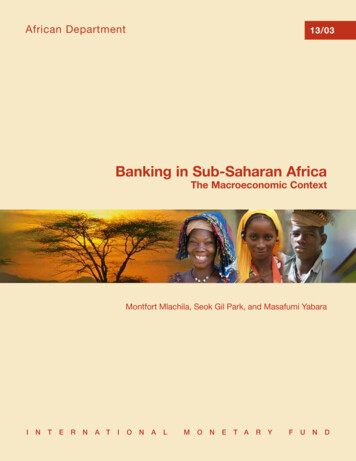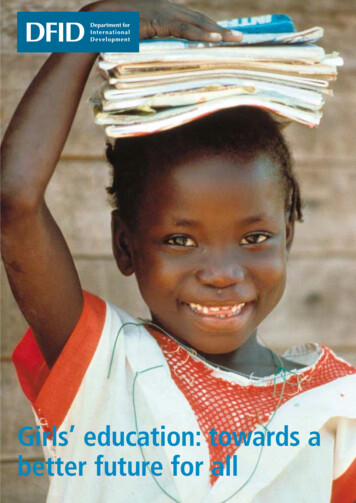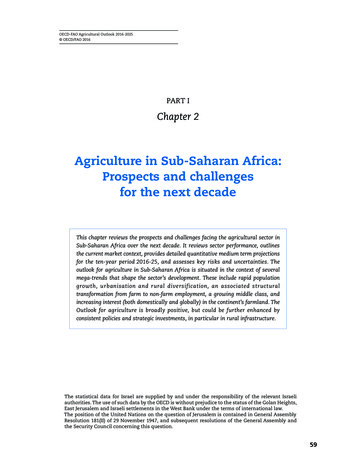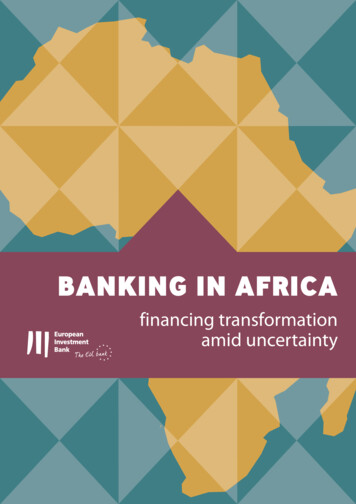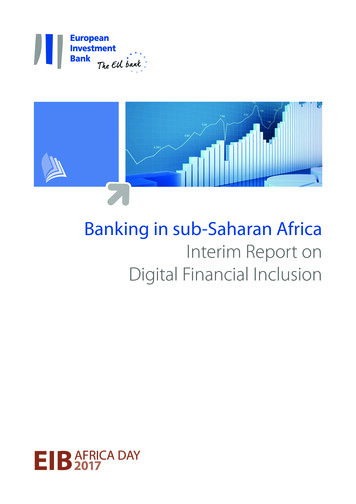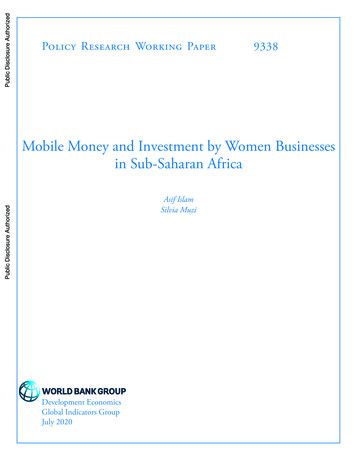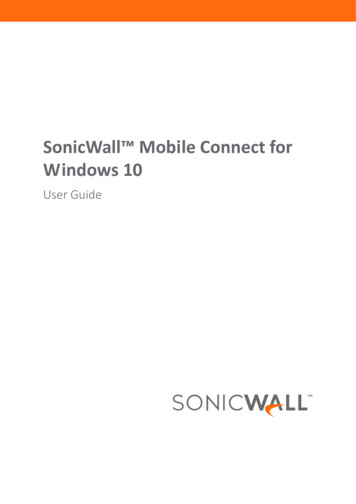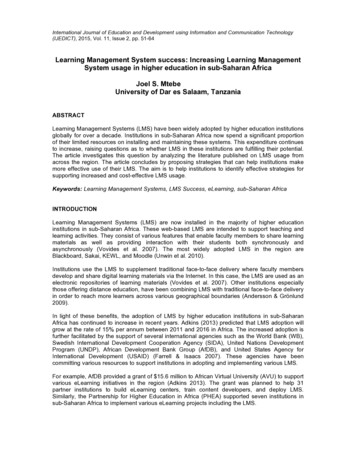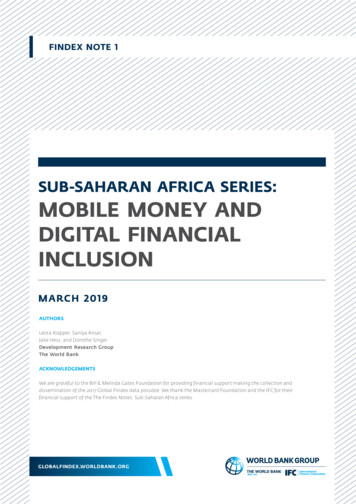
Transcription
FINDEX NOTE 1SUB-SAHARAN AFRICA SERIES:MOBILE MONEY ANDDIGITAL FINANCIALINCLUSIONMARCH 2019AUTHORSLeora Klapper, Saniya Ansar,Jake Hess, and Dorothe SingerDevelopment Research GroupThe World BankACKNOWLEDGEMENTSWe are grateful to the Bill & Melinda Gates Foundation for providing financial support making the collection anddissemination of the 2017 Global Findex data possible. We thank the Mastercard Foundation and the IFC for theirfinancial support of the The Findex Notes: Sub-Saharan Africa series.GLOBALFINDEX.WORLDBANK.ORG
FINDEX NOTE 1MARCH 2019Sub-Saharan Africa: Mobilemoney and digital financialinclusionThroughout Sub-Saharan Africa, innovationis transforming how people conduct financialtransactions and live their lives. Mobile phonesand the availability of new digital technologiesare at the forefront of this change, helping todraw more and more people into the formaleconomy, potentially mitigating gender andincome inequality and stimulating developmentin areas ranging from farming to education.The Findex Notes: Sub-Saharan Africa series summarize data compiled by Global Findex from nationally representativesurveys of more than 150,000 adults in over 140 economies in 2017, including more than 35,000 adults in 35 economies inSub-Saharan Africa. Global Findex is the world’s most comprehensive data set on how adults save, borrow, make payments,and manage risk.IN THIS NOTEWe describe how adults in Sub-Saharan Africa are using digital payments through mobile phones and other digital technologies. The noteoutlines various opportunities to use technology to bring financial services to people who still have no financial accounts and it discussespersistent inequalities that may be curtailing development in the region.Sub-Saharan Africa is a trailblazer in the use of mobile money to conduct digital transactions. While the vast majority of adults around theworld who use formal financial services rely on traditional banks and financial institutions, in Sub-Saharan Africa, 21 percent of adults havemobile money accounts—by far the largest share of any region.Research is showing that as more and more people embrace mobile money accounts, a range of development benefits follow. Onestudy found that the adoption of mobile money accounts in Kenya helped lift 194,000 people out of poverty, and that the accountsproved especially beneficial for women. Mobile money has also been lauded as a fast and efficient method of sending and receivingfunds from a network of acquaintances during an emergency, potentially reducing the likelihood that those impacted by a financialcrisis will descend into poverty. The benefits extend to governments as well. In Niger, researchers found that distributing governmentsocial benefits digitally via mobile phone instead of through cash disbursements cut administrative costs by a fifth and helped toshift household decision making to women, who are increasingly acquiring mobile accounts.i More generally, the adoption of digitaltechnology is helping to improve economic prospects in the region. A study of 12 African economies found that the arrival of highspeed internet increased employment in high-skill jobs and spurred increases in business creation, productivity, and exports.iiFINDEX NOTES2
MARCH 2019FINDEX NOTE 1Mobile money is driving an increase in accountsIn Sub-Saharan Africa, 43 percent of adults have anaccount at a bank or with a mobile money serviceprovider, up from 34 percent in 2014, according to theGlobal Findex database.iii While the share of adults withan account at a financial institution rose by 4 percentagepoints from 2014-2017, the share with a mobile moneyaccount nearly doubled—to 21 percent. In Senegal,overall account ownership nearly tripled, mostly drivenby mobile money. In Cote d’Ivoire and Uganda, whilethe number of people with an account at a financialinstitution remained steady, the share of mobile moneyaccounts grew. Kenya’s progress reflected an increase inthe share of adults with both types of account. However,Ethiopia and Nigeria, the two most populous economiesin the region, are two notable exceptions with regard tothis trend: mobile money account ownership in thesetwo economies so far remains virtually non-existing.In 2014, mobile money accounts were largelyconcentrated in East Africa. Now, these accounts arespreading (Figure 1). In West Africa the share of adultsowning a mobile money accounts has risen to about 33percent in Burkina Faso, Cote d’Ivoire, and Senegal—andto 39 percent in Ghana. In Gabon and Namibia, nearly 45percent of adults have mobile money accounts. In EastAfrica account ownership remains high, particularly inKenya, where nearly 3 in 4 adults use mobile money.Account ownership is higher among men and thewealthyFigure 1: Account ownership rose in Sub-Saharan Africa between2014-2017Adults with an account thAfricaUganda2014 20172014 20172014 20172014 20172014 20172014 20172014 20177550250FI and MM accountsFI account onlyMM account onlySource: Global Findex database.Figure 2: Men are more likely than women to have an accountAdults with an account (%), 2017UgandaTabzaniaAcross Sub-Saharan Africa, 48 percent of men and 37percent of women have an account, a gender gap of11 percentage points. The size of the gender gap variesamong individual economies (Figure 2). In Nigeria, menare twice as likely as women to have an account, andgender gaps can also be found in economies such asCote d’Ivoire, Ethiopia, Mozambique, and Uganda. SouthAfrica is among the rare economies where women andmen are equally likely to have an account.South AfricaNigeriaGhanaEthiopiaCote rce: Global Findex databaseFINDEX NOTES3
MARCH 2019FINDEX NOTE 1Sub-Saharan Africa’s income gap is 18 percentagepoints: Among adults in the richest 60 percentof households within economies, half have anaccount. In the poorest 40 percent of householdswithin economies, a third have an account.Wealthier adults are roughly twice as likely aspoorer adults to have an account in economiessuch as Democratic Republic of Congo, Ethiopia,Madagascar, Mozambique, and Nigeria (Figure 3).There are some early, and untested signs thatmobile money accounts are helping to reduceinequality in access to financial services. Considerthe eight economies where 20 percent or moreadults have only a mobile money account: BurkinaFaso, Cote d’Ivoire, Gabon, Kenya, Senegal,Tanzania, Uganda, and Zimbabwe. In all but two —Burkina Faso and Tanzania — there is no significantdifference in the numbers of men and womenwith mobile money accounts. However, when itcomes to the share of men and women who haveboth mobile money accounts and accounts atfinancial institutions, nearly all of those countrieshave statistically significant gender gaps. Thepicture is similar for the income gap. All eight ofthe leading mobile money economies have incomegaps in the share of adults who have both typesof accounts. But only half of these economies—Burkina Faso, Cote d’Ivoire, Senegal, and Uganda—have an income gap in the share of adults whohave a mobile money account only. The data areencouraging, but much more research is neededto determine whether mobile money accounts canreduce inequality in access to financial services.Figure 3: Account ownership higher among wealthier adults thanpoorer adultsAdults with an account (%), 2017100 -75 -50 -25 -0-DRCEthiopiaKenyaMadagascar MozambiqueNigeriaSouthAfricaAdults in richest 60%of householdsAdults in poorest 40% ofhouseholdsSource: Global Findex database. Note: Data for the poorest 40 percent and richest 60 percent ofhouseholds are based on household income quintiles within economies.Figure 4: In Sub-Saharan Africa, unbanked adults face a range ofbarriers to getting an accountAdults without a financial institution account reporting barrieras a reason for not having one (%), 2017Religious reasonsFamily Memener already has an account3 in 4 unbanked adults say they have toolittle money for an accountAcross Sub-Saharan Africa, nearly 340 millionadults still have no account at a financialinstitution. To reveal barriers to financialinclusion, the Global Findex survey asked peoplewhy they do not have accounts at financialinstitutions. Nearly 75 percent of respondentssaid they had too little money to use an accountat a financial institution. Almost 30 percentcited lack of funds as the sole reason for nothaving an account (Figure 4). The next mostcommonly cited barriers were high costs,distance to financial institutions, and lack ofdocumentation, each of which was mentionedby about a quarter of adults with no financialinstitution account.Lack of trustDo not need an accountLack of necessary documentationFinancial institutions too far awayAccounts too expensiveNot enough money0Cited as sole reason20406080Cited with other reasonsSource: Global Findex databaseFINDEX NOTES4
MARCH 2019FINDEX NOTE 1The relative importance of barriers varies acrosseconomies. High costs are cited by nearly 40 percentof respondents in economies such as Central AfricanRepublic, Democratic Republic of Congo, Cote D’Ivoire,Gabon, Kenya, South Africa, and Tanzania; the shareexceeds 50 percent in Madagascar, and Uganda.Documentation is a big challenge in Madagascar andZimbabwe, where nearly half of adults without anaccount at a financial institution say they do not have thepaperwork needed to open an account.Figure 5: Mobile phone ownership higher among wealthier adultsthan poorer adultsAdults with a mobile phone (%), 20171007550Digital inclusion: Low mobile phone ownershipamong poorer adults25Another barrier to financial inclusion is access to digitaltechnology. Mobile phones have been central to SubSaharan Africa’s financial inclusion achievements—and further progress depends in part on ensuring thateveryone has access to this important technology.Poorer adults still lag wealthier adults in mobile phoneownership. Regionally, 69 percent of wealthier adultshave a mobile phone, compared to 53 percent of pooreradults—an income gap of 16 percentage points. Gaps of20 percentage points or more are found in economiessuch as Cameroon, Ethiopia, Mozambique, Tanzania,and Uganda (Figure 5). Mobile phone ownership is twiceas high among wealthier adults than poorer adults inDemocratic Republic of Congo and Madagascar. Bycontrast, income gaps are small or non-existent in Coted’Ivoire and South Africa.0CameroonCoted’IvoireDRCAdults in poorest 40% ofhouseholdsEthiopia MozambiqueSouthAfricaTanzaniaAdults in richest 60%of householdsSource: Global Findex database. Note: Data for the poorest 40 percent and richest 60 percent ofhouseholds are based on household income quintiles within economies.Figure 6: Increasing shares of adults make or receive digitalpaymentsAdults making or receiving digital payments in thepast year (%)100An uptick in digital transactions75Over the last three years, the share of adults in SubSaharan Africa who make or receive digital payments50rose from 27 percent to 34 percent. These payments caninclude but are not limited to retail transactions madethrough mobile phones and the internet, receipt ofwages, government payments, or agricultural payments25into an account, collecting domestic remittances intoan account, and payments through a debit card orcredit card. Within the region, use of digital payments0BurkinaCoteEthiopiaGhanaKenyaMadagascar Senegaltends to be higher in economies where mobile moneyFasod’Ivoireis widespread. In Kenya, for example, 80 percent ofAdults in richest 60% ofAdults in poorest 40%households (2017)of households (2014)adults use digital payments (Figure 6), which is roughlySource:GlobalFindexdatabasetwice the average in developing economies. The numberof adults using digital payments doubled in Ghana asmobile money ownership rose from 13 percent in 2014 to 39 percent in 2017. Elsewhere, the share is much lower, as in Ethiopia and Madagascar,where only about 1 in 7 adults use digital payments.Use of a debit card or credit card is low in Sub-Saharan Africa, reported by only 7 percent of adults regionally, though the share is significantlyhigher in economies such as Botswana (17 percent), South Africa (25 percent), Namibia (37 percent), and Mauritius (48 percent). Within SubSaharan Africa, about 1 in 10 adults make digital payments for utilities such as water and electricity. Since 2014, the share has increased more thanthreefold in Namibia—to 21 percent, and roughly doubled in Kenya—hitting 39 percent. Beyond improved safety and convenience, a key benefit ofFINDEX NOTES5
MARCH 2019FINDEX NOTE 1digital utility payments is that they help users getaccess to vital services such as electricity throughpay-as-you-go models.ivIt seems likely that mobile phones will continueto outpace payment cards for digital transactionsin Sub-Saharan Africa. Regionally, 380 millionadults in Sub-Saharan Africa have a mobile phone.That is more than three and a half times the sharewho have a debit card. Financial service providersoperating in the region would do well to focus onmobile phone-based transaction channels.Figure 7: More young adults are making or receiving digital paymentsAdults aged 15-24 making or receiving digital payments inthe past year (%)806040Young people aredigital transactionsincreasinglymaking20Young people—defined as those between theages of 15 and 24—are adopting digital payments,particularly in economies where mobile moneyhas spread. In 2014, 20 percent of younger adults0in Sub-Saharan Africa sent or received outhAfricaFasopayments. Today, 30 percent do so. During the20172014same period, in Burkina Faso and Senegal, mobilemoney ownership among young people went fromSource: Global Findex database.3 percent to roughly 30 percent, while the shareof young people using digital payments increasednearly six-fold (Figure 7). Large jumps also occurred in Cameroon, Gabon, Ghana, and Namibia. Yet there remains room for furtherprogress. In Ethiopia—one of the region’s largest economies—only about 1 in 10 young people use digital payments.Women and the poor still lag on making or receiving digital paymentsInequality persists in the use of digital payments. Across Sub-Saharan Africa, the share of women making or receiving digitalpayments rose by 7 percentage points—to 30 percent. Yet men are still 9 percentage points more likely than women to use digitalpayments, and in economies such as Nigeria and Sierra Leone, use of digital payments is twice as high among men than women.Regionally, among adults in poorer households, 25 percent now make or receive digital payments, against 40 percent of adults inwealthier households. Wealthier adults are two times as likely as poorer adults to use such payments in economies like BurkinaFaso, Cameroon, Malawi, Nigeria, and Zambia.Opportunities to expand financial inclusion through digital paymentsMillions of unbanked adults in Sub-Saharan Africa receive routine payments in cash. These payments can be for wages, government socialbenefits, or the sale of agricultural goods. Moving such payments into accounts can be an effective way to increase access to formalfinancial services. For employers and the government, digital payments have the potential to reduce costs by removing the need tospend time and resources manually distributing cash payments. For recipients, digital payments can be safer and more convenient, andpotentially help build up savings balances. Mobile phones can also serve as an entry point to the formal financial system. Regionally, half ofunbanked adults in Sub-Saharan Africa—or 160 million unbanked adults—have a mobile phone. As businesses move to digitize payments,it is important to ensure that formal financial products are affordable and easy to use for the unbanked, many of whom are poor or havelimited literacy and numeracy. Vigorous consumer protections must be in place to safeguard new users from financial predation.FINDEX NOTES6
MARCH 2019FINDEX NOTE 1Agricultural payments offer one of the mostpromising opportunities to increase accountownership in Sub-Saharan Africa. Regionally,95 million adults—equivalent to almost 3 in 10unbanked adults—receive cash payments for thesale of agricultural goods (Map 1). That includesup to 50 million unbanked women. If thesepayments were transitioned into accounts, theshare of unbanked adults could fall by as much as40 percent in Uganda, 50 percent in Nigeria, and60 percent in Ethiopia. Overall in Sub-SaharanAfrica, 40 million unbanked adults own a mobilephone but still get paid in cash for agriculturalsales. Digital transactions potentially offer amore convenient way to receive payment. InEthiopia, 7 million unbanked adults—amongthem 3 million unbanked women—fall into thiscategory, as do 10 million unbanked in Nigeria,including 4 million women.Map 1: 95 million unbanked adults in Sub-Saharan Africa receiveagricultural payments in cashAdults without an account receiving payment for agricultural products in the past year in cash only, 20171 mln5 mln10 mlnThe common practice of sending money to friendsor relatives who reside in another part of the20 mlncountry also offers opportunities for increasingaccount ownership. Some 90 million unbankedSource: Global Findex database.Note: Data are not displayed for economies where the share of adults without an account is 5adults — roughly a quarter of the entire Subpercent or less or where the share receiving payments for agricultural products is 10 percent or less.Saharan unbanked population — sends or receivesdomestic remittances in cash or through an overthe-counter-service such as Western Union. In Nigeria alone, nearly 25 million unbanked adults send domestic remittances. If theseremittances were digitized in Cameroon, Cote d’Ivoire, Ghana, Nigeria, and South Africa, the share of unbanked adults in these economiescould fall by as much as a third.Beyond increasing account ownership, digitizing routine payments offers a great promise to increase the use of accounts among adultswho already have an account. Regionally, 10 million adults receive government wages, social benefits, or pension payments in cashdespite owning an account. That number includes 8 million account owners who own a mobile phone, among them nearly 2 million inEthiopia and 1 million in Nigeria. Private sector employers could do more in this area. Across Sub-Saharan Africa, roughly 1 in 10 accountowners—about 20 million—work in the private sector and get paid in cash. Most of these adults have a mobile phone, including 4 millionsuch private sector employees in Nigeria and 1 million in South Africa.ConclusionSub-Saharan Africa’s economies are being transformed as mobile money spreads across the continent. In 2014, mobile money accountswere found mostly in East Africa. Today, these accounts have spread across the region, especially West Africa, creating new opportunitiesfor people to make a wider range of financial transactions. Although women and the poor still lag, the Global Findex shows thatgovernments and businesses could boost ownership and use of formal financial services by transitioning routine cash payments intodigital channels.END NOTESiSee Demirguc-Kunt, Asli, Leora Klapper, and Dorothe Singer (2017), “Financial Inclusion and Inclusive Growth: A Review of Recent Empirical Evidence,”World Bank Policy Research Paper No. 8040.iiHjort, Jonas, and Jonas Poulsen (2018), “The arrival of fast internet and employment in Africa,” NBER Working Paper No. 23582.iiiThe full Global Findex dataset and methodology are available at https://globalfindex.worldbank.org/.ivSee, for example, Alexander G. Sotiriou et. al. (2018), “Strange Beasts: Making Sense of PAYGo Solar Business Models,” Forum 14, CGAP.FINDEX NOTES7
Sub-Saharan Africa is a trailblazer in the use of mobile money to conduct digital transactions. While the vast majority of adults around the world who use formal financial services rely on traditional banks and financial institutions, in Sub-Saharan Africa, 21 percent of adults have mobile money
